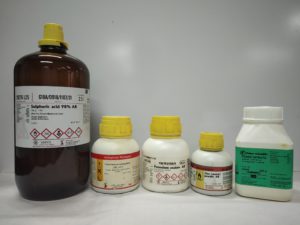The current experiment involves synthesis of a coordination complex of iron and oxalate followed by determination of its i) ligand strength by qualitative analysis and ii) composition of the complex by redox titration
Prerequisite (Theory)
- Redox titrations using potassium permanganate
- Concept of spectrochemical series
Techniques involved
Weighing of sample in balance, Dissolution of substances under hot condition, Filtration using Water Suction, titration of a solution by permanganate.
References
Jeffery, G.H., Bassett, J., Mendham, J., Denney, R.C., (1989). Vogel’s Textbook of Quantitative Chemical Analysis. John Wiley & Sons Inc, New York, 5th edition, chapter 10, (pp. 360-416)
Skoog, D.A., West, D., Holler, F.J., (1995). Fundamental of Analytical Chemistry. Harcourt Asia PTE Ltd, Singapore, 7 edition, chapter 17, (pp. 360-385)
These books give detailed account of the theoretical concepts of oxidation-reduction reactions using different examples. Writing half cell equations followed by complete balanced equations, titration curves, determination of the end point of titration, choice of indicators and examples of typical redox titrations carried out in the chemistry laboratories are dealt in depth.
https://chem.libretexts.org/Textbook_Maps/Analytical_Chemistry_Textbook_Maps/Map%3A_
Analytical_Chemistry_2.0_(Harvey)/09_Titrimetric_Methods/9.4%3A_Redox_Titrations
(accessed on September 2017)
Preparation of complex (Part A)
Glassware
| ▪ Beakers 100 mL | 2 |
| ▪ Glass rod | 1 |
| ▪ Ice Bath | 1 |
| ▪ Measuring cylinder 10mL | 1 |
Chemicals
| ▪ Fe(NO3)3.9H2O | 3.00 g/vial (1 vial) |
| ▪ K2C2O4. H2O | 8.00 g/vial (1 vial) |
Analysis of the complex (Part B)
Glassware
| ▪ Burette 50 mL | 1 |
| ▪ Conical flasks | 2 |
| ▪ Funnel | 1 |
| ▪ Filter paper | 2 |
| ▪ Measuring cylinder 50mL | 1 |
| ▪ Wash Bottle | 1 |
Chemicals
| ▪ KMnO4, 70 mL | |
| ▪ H2SO4, 4M, 60 mL | |
| ▪ Zn dust, 2.50g/vial (2 vials) |
Qualitative Tests (Part C)
Glassware
| ▪ Cavity Plate | 1 |
| ▪ Test tubes | 4 |
| ▪ Droppers | 4 |
Chemicals
| ▪ NaOH, 2 M | |
| ▪ KSCN, 0.1 M | |
| ▪ HCl, 0.1 M |
| ▪ Solution 1, Solution of Fe(NO3)3 | |
| ▪ Solution 2, Solution of the synthesized complex |
Hazard Symbols
Corrosive to skin ![]()
Oxidizing ![]()
Toxic ![]()
Irritant ![]()
Harmful to environment ![]()
Flammable ![]()
Transition elements are known to form variety of co-ordination complexes. These complexes are often highly colored and depending on the ligand, the color of a given complex varies for a given transition element.
For example, Fe(III) shows a variety of colors with different ligands like, oxalate, thiocyanate, cyanide, chloride, water etc. Some of these complexes are shown below.

In this experiment we will prepare a co-ordination complex of Fe (III) and oxalate in part A. In part B of the experiment, we will be analyzing the given complex for its iron and oxalate contents using titration technique. The molecular formula of the prepared complex is KaFebOxc.dH2O.
In part C, we will be performing some qualitative tests with solutions of iron (III) nitrate and the complex. The qualitative tests are conducted for comparing the strength of different ligands that bind with iron.
Procedure:
PART A: Synthesis of the complex
You are supplied with 3.00 g of Fe(NO3)3.9H2O in a vial and 8.00g of K2C2O4.H2O in another vial. Transfer the Fe(III) nitrate to a beaker and dissolve it in 3 mL of water. In another beaker, dissolve the potassium oxalate in 8 mL of hot water. Add the Fe(III) nitrate solution slowly to the oxalate solution with constant stirring. After the entire addition is done, heat the contents for 5 minutes on the hot plate. Remove the beaker from the hot plate and allow it to cool for 2-3 minutes. Then transfer the beaker to a prepared ice bath and keep it for 15 to 20 minutes. Filter the product obtained by suction filtration and wash with ice-cold water. Allow the product to dry for a half an hour in air or 15 to 20 minutes in a preheated oven (Temperature = 70-75°C). At the end of this time interval, carefully transfer the product to the pre-weighed butter paper. Take the product for weighing to nearest weighing balance.
PART B: Analysis of the synthesized co-ordination complex of iron
Determination of the oxalate content:
A sample of 0.250 g will be weighed in duplicate for analysis. Transfer the contents of one vial completely to a clean conical flask. Add 25 mL of 4 M H2SO4. Heat the solution on a hot plate to 70 – 80°C. Remove the flask from the hot plate and titrate the hot solution against standardized KMnO4 till it is light pink in colour.
Do not discard the contents after the titration, as you will be estimating iron from the same solution.
Determination of the iron content:
After titration of oxalate, to the same solution, carefully add one vial of zinc powder. After 1 or 2 minutes, keep the solution on the hot plate. Boil the solution for 10-15 minutes. Carefully remove the flask from the hot plate and allow the solution to cool. If necessary, filter the solution using a filter paper. Titrate the solution/filtrate agaia nst standardized KMnO4 solution. Perform both the titrations with another sample. Enter your results in the answer sheet.
PART C: Comparison of binding strength of different ligands
You are given 0.1 M solution of Fe(NO3)3 (that is, Solution 1) and of the complex (that is, Solution 2). In solution 1, iron exists as [Fe(H2O)6]3+.
Carry out the following tests in the supplied cavity plates and report your observations. If required some tests can also be performed in test tubes.
| Solution tested (5 drops) | Reagent added (5 drops) | Observations |
|---|---|---|
| Solution 1 | 2 M NaOH | |
| Solution 2 | 2 M NaOH | |
| Solution 1 | 0.1 M HCl | |
| Solution 2 | 0.1 M HCl | |
| Solution 1 | 0.1 M KSCN | |
| Solution 2 | 0.1 M KSCN |
Based on the observations, arrange the ligands, that is, H2O, OH-, Cl-, SCN- and C2O4‾2 on the basis of their binding strength with iron. Explain your answer in brief.
Observations, Calculations and Questionnaire
Mass of the pre-weighed butter paper
Mass of product + butter paper
Mass of product
Color of the product
Concentration of KMnO4
(will be supplied by the teacher/instructor)
| Trial I | Trial II | |||
| Titration 1 |
Titration 2 |
Titration 1 |
Titration 2 |
|
| Initial burette reading (mL) | ||||
| Final burette reading (mL) | ||||
| Volume of KMnO4 (mL) | ||||
- After addition of 4M H2SO4 the pH of the solution is close to 1. For oxalic acid, pKa1 = 1.27 and pKa2 = 4.27. When oxalate is released from the complex at this pH it will be converted to
H2C2O4

HC2O4̅

C2O42-

- Write the balanced chemical equation for the reaction involved in the titration of oxalate with KMnO4.
- Write the reactions that take place
- immediately after the addition of Zn dust to the flask and
- when the solution is boiled
- titration of iron with KMnO4.
- Calculate the amount of iron and oxalate for any one of the trials. (Show the main steps in your calculation).
- Calculate the potassium and water content in the complex.
- The molar ratio of iron: oxalate: potassium: water in the given complex is based on your calculations, write the balanced chemical equation/s for the reaction/s involved in the formation of the complex.
- Calculate the theoretical yield of the coordination complex.
- The percentage yield of the complex as a function of the mass of Fe(NO3)3.9H2O taken for synthesis.
This video is shot in the chemistry laboratory of HBCSE and can be used for educational purposes
This video is shot in the chemistry laboratory of HBCSE and can be used for educational purposes


